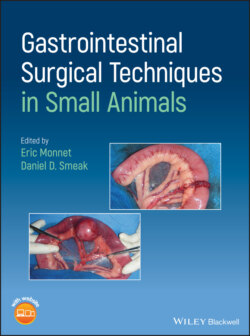Читать книгу Gastrointestinal Surgical Techniques in Small Animals - Группа авторов - Страница 51
3.5.2 Cushing and Connell
ОглавлениеThese continuous patterns are often used to close hollow organs because they cause tissue inversion and provide a reliable leak‐proof seal. The Cushing and Connell patterns are similar except that the Cushing pattern is placed so that the suture purchases the serosa, muscularis, and submucosa, but it does not pierce the mucosa so it is not exposed to the lumen of the organ (Figure 3.3). For the Connell pattern, suture extends into the organ lumen (Figure 3.4). Some surgeons choose to avoid penetrating the lumen of hollow viscera to help reduce the potential for contamination from the needle track in highly contaminated visceral organs. The author prefers to begin these two inverting lines with a Lembert stitch which helps to begin tissue inversion with the first stitch. Subsequent bites are more readily inverted after the Lembert stitch is placed. The suture line is continued taking alternating 5 mm bites of tissue, 3 mm away and parallel to the incision line. Once the needle exits the bite, it is passed directly across the incision and another similar parallel bite of tissue is taken. This suture line is repeated until the incision is closed. The suture strand is pulled firmly to create inversion and to reduce suture exposure on the serosal surface.
Figure 3.3
Figure 3.4
